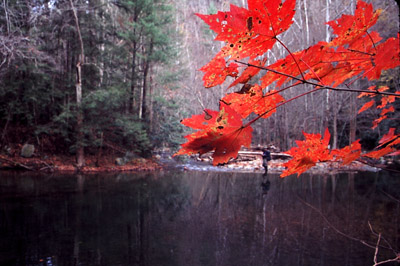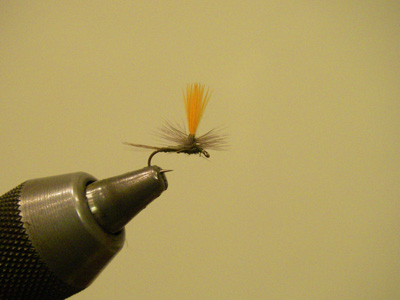Fall is almost upon us and with it comes some great dry fly fishing. Rising trout in the fall are more difficult to coax to a dry fly than they are in the spring. Spring hatches are usually more robust with more bugs on the water. Additionally, the bugs are much larger.
Low water conditions in the fall give trout plenty of time to inspect a fly in the slow flow.
While fish rise regularly in the autumn, the insects they are eating are much smaller and the water conditions are almost always lower. This gives the fish more time to inspect your offering in low, clear water. The swift, choppy flows of spring are more forgiving and trout will occasionally slash at a variety of fly patterns before they can make an informed decision.
Size and color of the fly are the two most important factors to fool a trout. Unfortunately the most prolific hatches found in the Smokies October through November are small and dark. These can be exceptionally difficult to see on the water.
Here’s a fly that we use for ourselves and tie on for our guide customers. It’s extremely effective at fooling trout and most anglers can see it quite clearly. This makes it easier to get a good drift and you’re far less likely to miss a strike when you see the fly instead of straining to see a fly that is actually five feet left of where you’re looking.
I like to use turkey flats for the parachute post for several reasons. First of all there is no need to stack turkey flats like you do with calf hair. Turkey flats also tie in much flatter than calf hair. This is important when you’re tying a small fly and trying to keep the body from getting too fat. Last, turkey flats retain very little water when you fish the fly. This is a great material that allows a tyer to work faster, make a better fly, and allows the fly to float better.
Hi-Vis Parachute Blue Wing Olive
Hook: Standard Dry Fly #18 – #20
Thread: 8/0 Olive
Wing: Day Glow Orange Turkey Flat
Tailing: Dark or Medium Dun Hackle Fibers
Body: Blue Wing Olive Superfine Dubbing
Hackle: Dark or Medium Dun Dry Fly Hackle
Step 1: Tie the thread onto the hook at about one hook eye length behind the eye. Clip about 1/3 of the even portion of the turkey flat and tie onto the hook. The wing should be as long as the length of the hook.
Step 2: Pull the wing back and wrap thread up against it to get it to stand up. Wrap the thread around the base of the wing. This will keep the fibers neat and tight and give a firm base to wrap hackle later.
Step 3: Tie in a clump of hackle fibers at the back of the level portion of the hook.
Step 4: Dub a spare amount of dubbing on the thread. Only a small amount is required and no wax should be needed. Wrap it on the hook to create a tapered body. Wrap in front of the wing and finsh dubbing just behind the wing. About 3-4 wraps of dubbing should remain.
Step 5: Strip the hackle fibers from the base of the spine of the hackle. Tie it in on the directly against the front base of the wing. The remainder of dubbing should be used entirely.
Step 6: Wrap the hackle 3-5 times around the base of the wing depending on how heavy you like your flies hackled. Start wrapping near the top of the thread wraps and make each successive turn below the previous one. Tie the hackle off and clip it clean. Make a few more thread wraps over that then tie off with a series of half hitches or whip finish.








